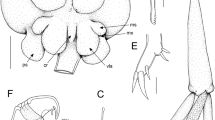Abstract
A new species of parasitic copepod of the family Lernanthropidae is described from an immigrant population of the blotchfin dragonet Callionymus filamentosus Valenciennes (family Callionymidae) in the Eastern Mediterranean. Both sexes are described on the basis of material caught in Egyptian waters off the Alexandria coast at Abuqir. The new species shares with Lernanthropus breviculus Kabata, 1979 the possession of a small dorsal plate on the trunk that is so narrow at its origin that it does not overlap the bases of the fourth legs, which are therefore visible in dorsal view. These species differ in the shape of the cephalothorax and in the extent of the dorsal plate, which is shorter in the new species, revealing the caudal rami in dorsal view. Previous records of parasitic copepods utilising callionymids as hosts are reviewed: most belong to the families Pennellidae and Chondracanthidae.




Similar content being viewed by others
References
Baird, W. (1850). The Natural History of the British Entomostraca. London: The Ray Society, 364 pp.
Basset-Smith, P. W. (1896). Notes on the parasitic Copepoda of fish obtained at Plymouth, with descriptions of new species. Annals and Magazine of Natural History, 18, 8–16.
Boxshall, G. A. (1974). Infections with parasitic copepods in North Sea marine fishes. Journal of the Marine Biological Association of the United Kingdom, 54, 355–372.
Boxshall, G. A. (1990). The skeletomusculature of siphonostomatoid copepods, with an analysis of adaptive radiation in structure of the oral cone. Philosophical Transactions of the Royal Society, London, series B, 328, 167–212.
Boxshall, G. A., & Halsey, S. H. (2004). An introduction to copepod diversity. London: The Ray Society, 966 pp.
Delamare Deboutteville, C. (1950). Copépodes parasites de poisons de Banyuls (1re série). Vie et Milieu, 1, 305–309.
Delamare Deboutteville, C., & Nunes-Ruivo, L. (1955). Remarques sur le développement de la femelle d’Haemobaphoides (T. Scott) et analyse critique des genres Haemobaphes Steenstrup et Lütken, Haemobaphoides T. et A. Scott et Collipravus Wilson (Crustacea Copepoda). Bulletin de la Société Zoologique de France, 80, 27–37.
El-Rashidy, H. H., & Boxshall, G. A. (2009). Parasites gained: alien parasites switching to native hosts. Journal of Parasitology, 95, 1326–1329.
El-Rashidy, H. H., & Boxshall, G. A. (2010). Parasitic copepods on immigrant and native clupeid fishes caught in Egyptian coastal waters off Alexandria. Systematic Parasitology, 76, 19–38.
Froese, R., & Pauly, D. (2011). FishBase. World Wide Web Electronic Publication. [Consulted on 15 May 2011].
Golani, D., Orsi-Relini, L., Massuti, E., & Quignard, J.-P. (2002). Fishes. CIESM Atlas of exotic species in the Mediterranean (ed. F. Briand). Monaco: CIESM Publishers, 256 pp.
Hamond, R. (1969). The copepods parasitic on Norfolk marine fishes. Transactions of the Norfolk and Norwich Naturalists’ Society, 21, 229–234.
Hansen, H.J. (1923). Crustacea Copepoda. II. Copepoda parasita and hemiparasita. Danish Ingolf Expedition, 3(7), 1–92, pls 1–5.
Ho, J.-S., & Dojiri, M. (1988). Copepods of the family Chondracanthidae parasitic on Australian marine fishes. Australian Journal of Zoology, 36, 273–291.
Huys, R., & Boxshall, G. A. (1991). Copepod evolution. London: The Ray Society, 468 pp.
Kabata, Z. (1958). Lernaeocera obtusa n. sp.; its biology and its effects on the haddock. Marine Research Edinburgh, 1958 (No. 3), 1–26.
Kabata, Z. (1979a). Parasitic copepods of British fishes. London: The Ray Society, 468 pp.
Kabata, Z. (1979b). Parasitic copepods of Australian fishes, XII. Family Lernanthropidae. Crustaceana, 37, 198–213.
Palm, H. W., Klimpel, S., & Bucher, C. (1999). Checklist of metazoan fish parasites of German coastal waters. Berichte aus dem Institut fur Meereskunde an der Christian-Albrechts-Universität Kiel, 307, 1–148.
Raibaut, A., Combes, C., & Benoit, F. (1998). Analysis of the parasitic copepod species richness among Mediterranean fish. Journal of Marine Systems, 15, 185–206.
Reimer, L. W. (1986). Parasitic copepods of fishes from the coast of Mozambique. Wiadomości Parazytologiczne, 32, 505–506.
Schuurmans Stekhoven, J. H. (1936). Beobachtungen zur Morphologie und Physiologie der Lernaeocera branchialis und L. lusci. Zeitschrift für Parasitenkunde, 8, 659–696.
Scott, T. (1900). Notes on some parasites of fishes. 18th Annual Report of the Fishery Board for Scotland, 144–188, pls V–VIII.
Scott, A. (1929). The copepod parasites of Irish Sea fishes. Proceedings and Transactions of the Liverpool Biological Society, 43, 81–119.
Shiino, S. M. (1955). Copepods parasitic on Japanese fishes. 9. Family Chondracanthidae, Subfamily Chondracanthinae. Report of the Faculty of Fisheries, Prefectural University of Mie, 2, 70–111.
Shiino, S. M. (1956). Copepods parasitic on Japanese fishes. 11. Genus Phrixocephalus. Report of the Faculty of Fisheries, Prefectural University of Mie, 2, 242–267.
Uyeno, D., & Nagasawa, K. (2010). Three new species of the family Pennellidae (Copepoda: Siphonostomatoida) from gobiid fishes (Actinopterygii: Perciformes) in coastal waters of the western Pacific Ocean. Zootaxa, 2687, 29–44.
Van Damme, P. A., Maertens, D., Arrum, A., Hamerlynck, O., & Ollevier, F. (1993). The role of Callionymus lyra and C. reticulatus in the life cycle of Lernaeocera lusci in Belgian coastal waters (Southern Bight of the North Sea). Journal of Fish Biology, 42, 395–401.
Yamaguti, S. (1939). Parasitic copepods from fishes of Japan. Part 4. Cyclopoida, II. In: Volumen Jubilare pro Prof. Sadao Yoshida, 2, 391–415, pls 1–13.
Acknowledgement
The second author would like to thank Prof. B. Galil for alerting him to the presence of this copepod in the Eastern Mediterranean and for allowing him to examine the material collected by B. Galil, M. Goren and A. Diamant.
Author information
Authors and Affiliations
Corresponding author
Rights and permissions
About this article
Cite this article
El-Rashidy, H.H., Boxshall, G.A. A new copepod (Siphonostomatoida: Lernanthropidae) parasitic on a Red Sea immigrant dragonet (Actinopterygii: Callionymidae), with a review of records of parasitic copepods from dragonets. Syst Parasitol 81, 87–96 (2012). https://doi.org/10.1007/s11230-011-9326-7
Received:
Accepted:
Published:
Issue Date:
DOI: https://doi.org/10.1007/s11230-011-9326-7




